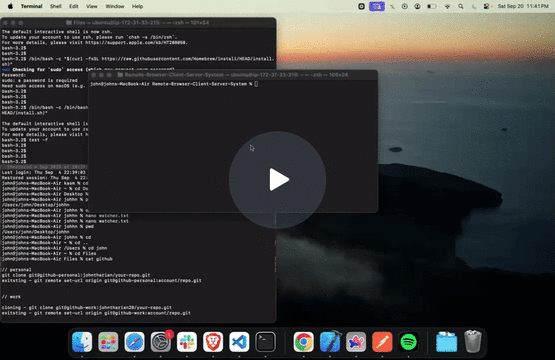Real-time Remote Browser Session Streamer
A real-time remote browser streaming system enabling seamless interaction with server-side browser instances through a web interface.
Overview
A real-time remote browser streaming system that allows users to interact with a browser instance running on a server through a web interface.
Click the image above to watch the full demo video
📋 Table of Contents
- 🏗️ Architecture & Design Choices
- 🚀 Setup
- 🛠️ Prerequisites
- 💻 Local Development
- 🔍 Troubleshooting
- 🌐 Server
- 🌐 Client
- 📈 Future Improvements
🏗️ Architecture and Design Choices
System Architecture
|
|
Technology Stack
1. Server-Side (Go)
-
Language/Framework: Go (Golang)
- Chosen for its excellent concurrency model and performance
- Built-in HTTP server for handling WebRTC signaling
- Strong type safety and standard library
-
WebRTC (Pion Library)
- Enables real-time, peer-to-peer communication
- Handles NAT traversal using STUN servers
- Efficient data channel for browser control messages
- Low-latency video streaming capabilities
-
Playwright-Go
- Cross-browser automation
- Headless browser control
- Screenshot capture for screen sharing
- JavaScript execution in the browser context
2. Client-Side (JavaScript/HTML5)
-
WebRTC Data Channels
- Bi-directional communication
- Low-latency message passing
-
Canvas API
- Efficient rendering of remote screen updates
Key Design Decisions
-
WebRTC Over WebSockets
- Chose WebRTC for its peer-to-peer capabilities
- Lower latency for real-time interaction
- Better handling of media streaming
- Built-in NAT traversal
-
Screenshot-Based Streaming
- Simple implementation using Playwright’s screenshot API
- Frame-by-frame updates for screen sharing
-
Graceful Shutdown
- Proper cleanup of resources on server shutdown
- Signal handling for Ctrl+C
- Graceful degradation of services
-
Security Considerations
- Input validation on both client and server
- CORS protection
-
Error Handling
- Comprehensive logging throughout the application
- Graceful recovery from panics
- User-friendly error messages
🚀 Setup
- Clone the repository and navigate to the project directory:
1 2git clone https://github.com/johntharian/Remote-Browser-Client-Server-System.git cd Remote-Browser-Client-Server-System
Prerequisites
Install Go
Download the installer from golang.org/dl - Run the installer and follow the prompts
Install Node.js and npm
-
macOS (using Homebrew):
1brew install node -
Linux (Debian/Ubuntu):
1 2curl -fsSL https://deb.nodesource.com/setup_lts.x | sudo -E bash - sudo apt-get install -y nodejs -
Windows:
- Download the LTS version from nodejs.org
- Run the installer and follow the prompts
-
Verify installations:
1 2 3go version node --version npx --version
Local Development
-
Install Go dependencies:
1go mod tidy -
Install Playwright
1 2 3 4 5# Install Playwright go install github.com/playwright-community/playwright-go/cmd/playwright@v0.5200.0 # Install browsers (this might take a few minutes) npx playwright install --with-deps -
Verify Playwright installation:
1npx playwright --version -
Start the WebRTC server:
1go run cmd/server/main.go -
Open index.html (client) in a browser
Troubleshooting
- If you encounter browser-related issues, try reinstalling Playwright browsers:
1npx playwright install --force
Server
- Runs a browser instance using Playwright.
- Streams the rendered contents of the browser (e.g., a webpage opened in the browser instance) to connected clients.
- Accepts user actions (e.g., clicks, typing, navigation) from a client and applies them to the Playwright browser instance.
Client
- Runs locally in a browser.
- Displays the streamed contents of the remote Playwright browser session.
- Lets the user interact with the page (e.g., by clicking, scrolling, or typing).
- Sends those interactions back to the server, where they are executed in the Playwright-controlled browser.
Future Improvements
Core Functionality
- Chrome DevTools Protocol (CDP) Integration
- Leverage Playwright’s CDP support for more efficient browser session streaming
- Implement frame-by-frame video streaming for smoother remote interaction
Security & Reliability
- Security Features
- Add authentication and authorization
- Implement session encryption
- Add rate limiting and abuse prevention
Scalability
- Multi-User Support
- Session sharing capabilities
- Collaborative browsing features
Last modified on 2025-10-03
